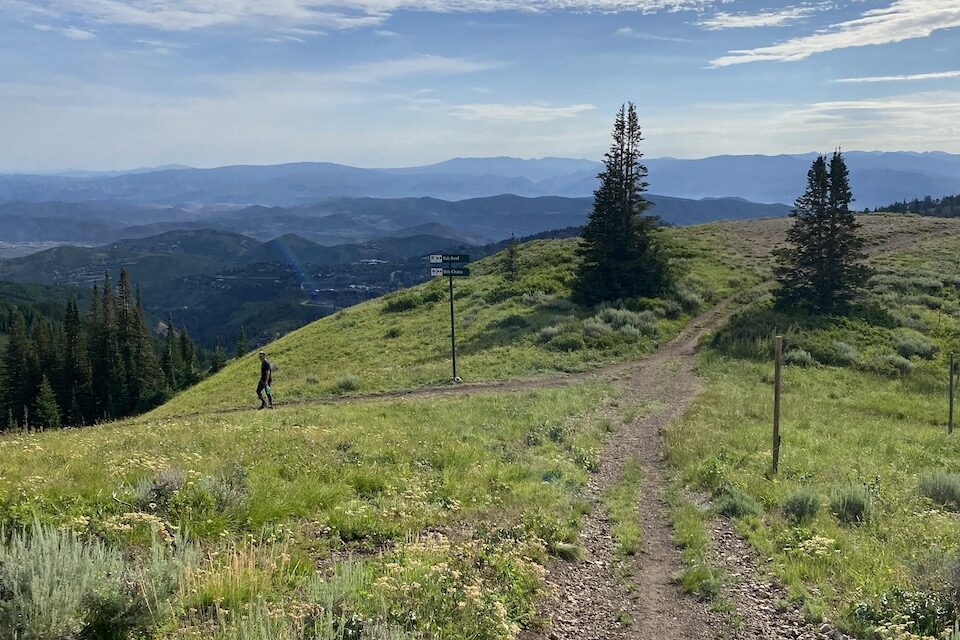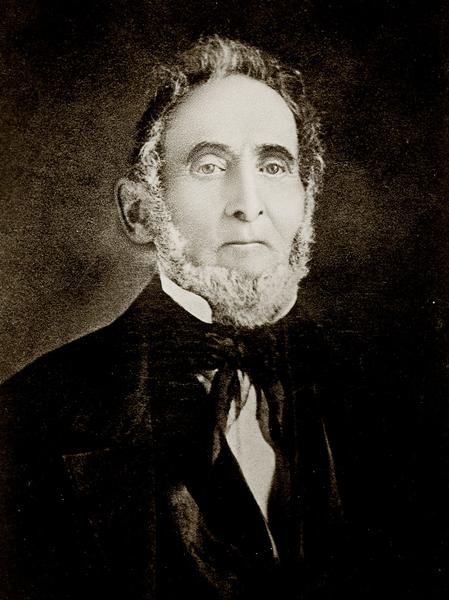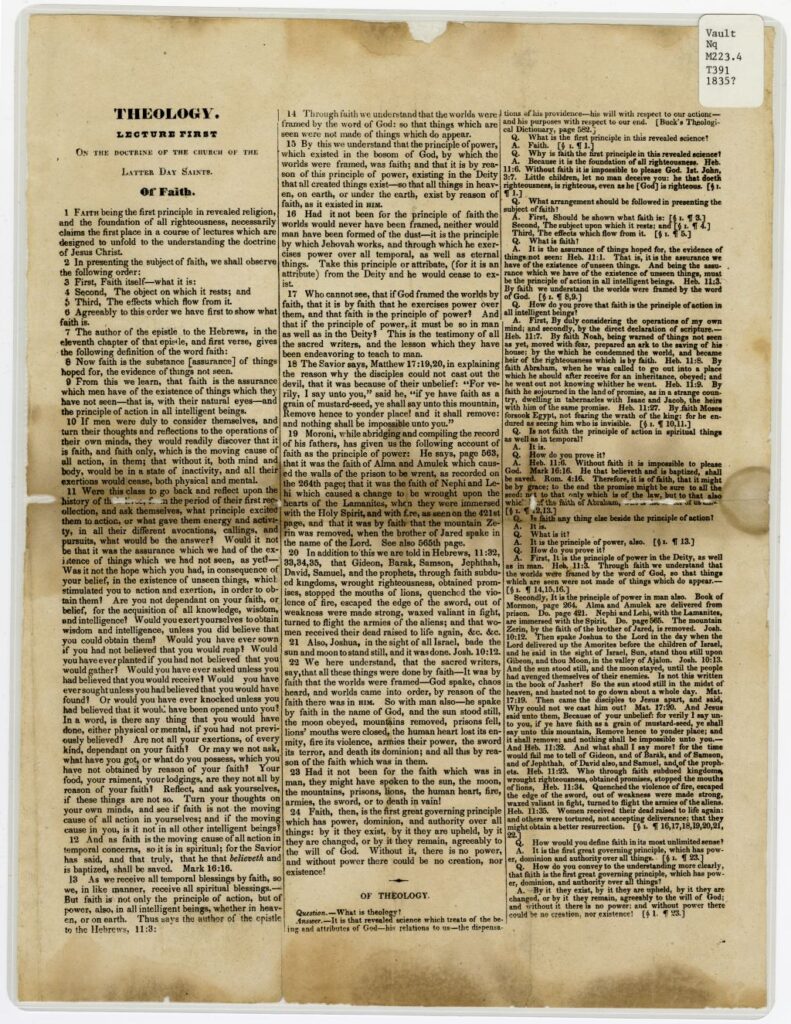I read and studied the Lectures on Faith a long time ago and found them to be confusing. They did not feel like revelation, nor did they speak to me as other texts. It seemed to be written by an old schoolmaster who did not even have the best pedagogy. I know a lot of people believe that Joseph Smith was the author. But I do not. And now, I have company in that thought. According to the Joseph Smith Papers Project, “modern scholars largely agree that Rigdon authored most or all of the lectures.” That’s right, Sidney Rigdon, an influential Baptist preacher, was probably the author of these lectures on faith. That makes sense to me.
Joseph Smith had left Oliver Cowdery and Sidney Rigdon in Ohio in charge of arranging the church covenants to be published:
When JS returned from Missouri to Ohio in August 1834, focus again turned to publishing the revelations. In September the Kirtland high council appointed a committee consisting of JS, Oliver Cowdery, Sidney Rigdon, and Frederick G. Williams to publish a work “arrange[d from] the items of the doctrine of Jesus Christ.” This committee was assigned to draw “from the bible, book of mormon, and the revelations which have been given to the church up to this date.”10 While a single volume containing excerpts from the Bible, Book of Mormon, and revelation texts was the original intention, the concept was later modified. As the bipartite title “Doctrine and Covenants” suggests, the new book was made up of two parts. The first part, on “the doctrine of the church,”11 comprised a series of seven doctrinal lectures on the subject of faith, first prepared as a course of instruction for the School of the Elders held in the second Kirtland printing office in the winter of 1834–1835.12 Lecture one was contemporaneously published as a broadside and lectures five and six were published in the May 1835 issue of the Latter Day Saints’ Messenger and Advocate,13 but there is no known manuscript copy of any of the lectures. Although no JS-era published version states who authored the lectures, they were traditionally attributed to JS. Modern scholars, however, largely agree that Rigdon authored most or all of the lectures.14 (Historical note, Joseph Smith Papers)
And this from Appendix 1: First Theological Lecture on Faith, circa January–May 1835:
Sometime in the first months of 1835, the church’s printing office in Kirtland, Ohio, printed this broadside of a theological lecture “on the doctrine of the church of the Latter Day Saints.” The lecture was designated as the first in a series of several presentations on faith given at a theological school in Kirtland in the winter of 1834–1835.1 A June 1834 revelation declared that before church members could reclaim their lands in Jackson County, God’s people needed to “be taught more perfectly, and have experience and know more perfectly concerning their duty, and the things which I [God] require at their hands.”2 Thereafter, several of the “first Elders” in Missouri were appointed to travel to Kirtland to receive an endowment of power. Some of them were also told to assist in gathering the “strength of the Lord’s house” and in preaching the gospel so that Zion could be redeemed.3 As these elders began to reach Kirtland in fall 1834, JS and other leaders made “preperations for the school for the Elders, wherein they might be more perfectly instructed, in the great things of God during the coming winter.”4 The lectures were presented at this school and directed to elders who were preparing to proselytize, with the goal of “unfold[ing] to the understanding the doctrine of Jesus Christ.” They also provided instruction necessary for those who were preaching and gathering the elect to Zion, thereby facilitating the redemption of Zion. Such instruction prefaced an intense period of missionary work in 1835, when numerous men, including those newly designated as apostles or seventies, were sent from Kirtland to preach in the eastern United States and Canada.5
The School of the Elders, which met in the schoolroom on the lower story of the printing office, was apparently functioning by December 1834. A later JS history explains that by 1 December, it was “well attended.” The history also states that participants in the school “gave the most studious attention to the all important object, of qualifying themselves, as messengers of Jesus Christ, to be ready to do his will.”6 According to Harrison Burgess, who said he attended this “high school together with Brothers Joseph & Hyram [Hyrum Smith],” the theological lectures were given during evening sessions devoted to “instruction in the principles of our Faith and religion.”7 The lectures appear to have been concluded by January 1835, when JS and others apparently began preparing them for publication.8
Although numerous scholars have tried to identify the author of the lectures presented in the school,9 contemporary records are largely silent as to who actually wrote or delivered them. None of the 1835 publications of the lectures attributed authorship to any individual.10 However, it seems likely that Sidney Rigdon had a large hand in composing the lectures. Jedediah M. Grant, who was living in Kirtland in 1835, later remembered that “Elders Smith, Rigdon, and others, acted as teachers” in the school, though he did not specify who gave the lectures.11 Zebedee Coltrin’s memories also tie the lectures to Rigdon, stating that the presentations were given at the school “where Sidney presided.”12 After Rigdon broke with Brigham Young and the Twelve Apostles in 1844, the periodical for the church that Rigdon led republished the lectures in 1845 and 1846, stating that they presented the principle of faith “in a clear and interesting manner.”13 Although the periodical does not declare the lectures’ authorship, it seems unlikely that Rigdon’s new church would have published the lectures had Rigdon not had a prominent role in their composition. Perhaps the most direct evidence of Rigdon’s involvement is Brigham Young’s characterization of the lectures in 1860 as ones “Brother Sidney prepared.” Young was in Kirtland at this time and likely attended the school.14Even though Rigdon likely had a large role in producing the lectures, JS was apparently involved as well. Jedediah M. Grant’s recollection of JS as one of the teachers in the School of the Elders suggests JS may have helped present the lectures. Entries in a later JS history, which were prepared by Willard Richards in 1843, also state that JS devoted much time to the school in late 1834 and early 1835, to the point that both the school and the lectures were “absorb[ing], for the time being, every thing else of a temporal nature.” In addition, the history states that in January 1835, JS engaged in “preparing the Lectures on Theology for publication in the Book of Doctrine and covenants, which the committee appointed last September, were now compiling.”15 It is not clear from extant records what form this preparation took or how extensively JS was involved, nor is it clear how different the lectures in their published form were from their oral delivery.16 However, as part of the committee commissioned to compile the Doctrine and Covenants, JS and other members of the church presidency signed their names to the book’s preface, which declared that the seven lectures included in the volume “embrac[ed] the important doctrine of salvation.”17
The broadside of the first lecture is reproduced here as an example of the lectures as a whole.18 Because JS’s role in producing the lectures cannot be clearly determined, the first lecture is presented as an appendix of the volume rather than as a featured text. It is unclear why the first lecture was published separately as a broadside, though several of JS’s revelations had previously been published as broadsides and distributed to church members.19 It may be that elders preaching in 1835 took the broadside with them as they traveled, perhaps leaving copies with church members or others who were interested.
In August 1835, an assembly of church members voted to approve the Doctrine and Covenants as compiled, thereby making the book “a law. unto the church, and a rule of faith and practice unto the same.” In the course of the approval process, some church officers commented specifically on the lectures. Leonard Rich, one of the presidents of the Seventy, stated “that he had examined the Lectures and many of the Revelations” in the book and “knew that they were true by the testimony of the Holy Spirit of God given unto him.” Newel K. Whitney, the bishop in Ohio, similarly commented “that he had examined the Lectures . . . and that he believed them beyond a doubt.”20 The lectures remained part of the Doctrine and Covenants until 1921.21




